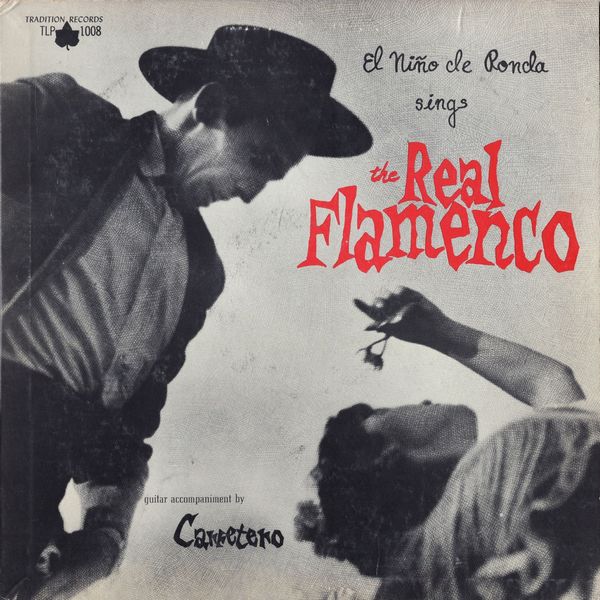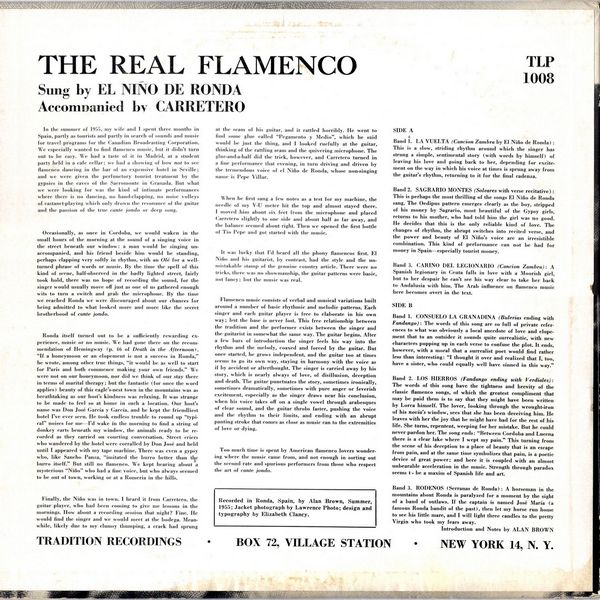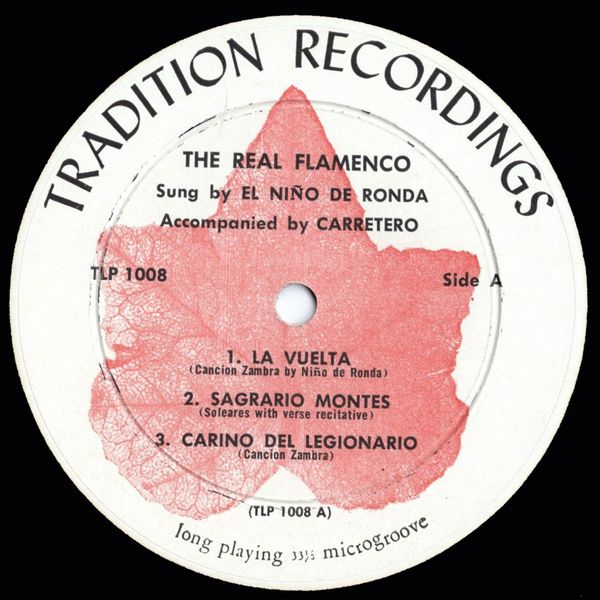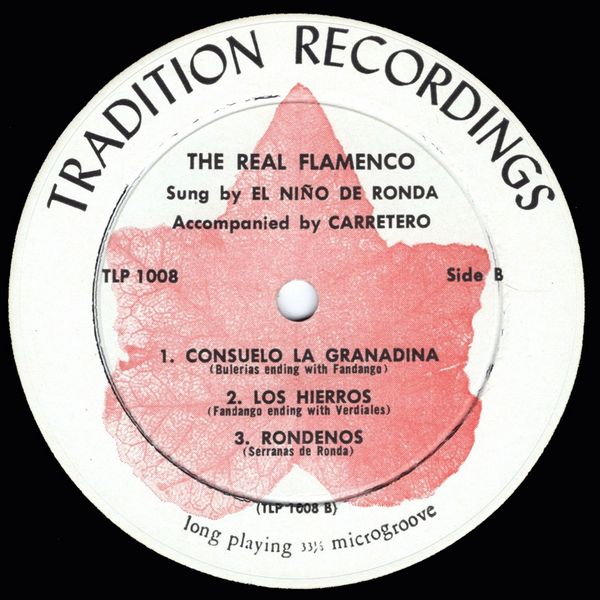

 |



|
Sleeve Notes
In the summer of 1955, my wife and I spent three months in Spain, partly as tourists and partly in search of sounds and music for travel programs for the Canadian Broadcasting Corporation. We especially wanted to find flamenco music, but it didn't turn out to be easy. We had a taste of it in Madrid, at a student party held in a cafe cellar; we had a showing of how not to see flamenco dancing in the bar of an expensive hotel in Seville; and we were given the perfunctory tourist treatment by the gypsies in the caves of the Sacromonte in Granada. But what we were looking for was the kind of intimate performances where there is no dancing, no hand-clapping, no noise volleys of castanet-playing which only drown the resonance of the guitar and the passion of the true cante jondo or deep song.
Occasionally, as once in Cordoba, we would waken in the small hours of the morning at the sound of a singing voice in the street beneath our window: a man would be singing unaccompanied, and his friend beside him would be standing, perhaps clapping very softly in rhythm, with an Ole for a well-turned phrase of words or music. By the time the spell of this kind of scene, half-observed in the badly lighted street, fairly took hold, there was no hope of recording the sound, for the singer would usually move off just as one of us gathered enough wits to turn a switch and grab the microphone. By the time we reached Ronda we were discouraged about our chances for being admitted to what looked more and more like the secret brotherhood of cante jondo.
Ronda itself turned out to be a sufficiently rewarding experience, music or no music. We had gone there on the recommendation of Hemingway (p. 46 of Death in the Afternoon). "If a honeymoon or an elopement is not a success in Ronda," he wrote, among other true things, "it would be as well to start for Paris and both commence making your own friends." We o were not on our honeymoon, nor did we think of our stay there in terms of marital therapy; but the fantastic (for once the word applies) beauty of this eagle's-nest town in the mountains was as breathtaking as our host's kindness was relaxing. It was strange to be made to feel so at home in such a location. Our host's name was Don Jose Garcia y Garcia, and he kept the friendliest hotel I've ever seen. He took endless trouble to round up "typical" noises for me — I'd wake in the morning to find a string of donkey carts beneath my window, the animals ready to be recorded as they carried on courting conversation. Street criers who wandered by the hotel were corralled by Don Jose and held until I appeared with my tape machine. There was even a gypsy who, like Sancho Panza, "imitated the burro better than the burro itself." But still no flamenco. We kept hearing about a mysterious "Nino" who had a fine voice, but who always seemed to be out of town, working or at a Romeria in the hills.
Finally, the Nino was in town. I heard it from Carretero, the guitar player, who had been coming to give me lessons in the mornings. How about a recording session that night? Fine. He would find the singer and we would meet at the bodega. Meanwhile, likely due to my clumsy thumping, a crack had sprung at the seam of his guitar, and it rattled horribly. He went to find some glue called "Pegamento y Medio", which he said would be just the thing, and I looked ruefully at the guitar, thinking of the rattling seam and the quivering microphone. The glue-and-a-half did the trick, however, and Carretcro turned in a fine performance that evening, in turn driving and driven by the tremendous voice of el Nino de Ronda, whose non-singing name is Pepe Villar.
When he first sang a few notes as a test for my machine, the needle of my V-U meter hit the top and almost stayed there. I moved him about six feet from the microphone and placed Carretero slightly to one side and about half as far away, and the balance seemed about right. Then we opened the first bottle of Tio Pepe and got started with the music.
It was lucky that I'd heard all the phony flamencos first. El Nino and his guitarist, by contrast, had the style and the unmistakable stamp of the genuine country article. There were no tricks, there was no showmanship, the guitar patterns were basic, not fancy: but the music was real.
Flamenco music consists of verbal and musical variations built around a number of basic rhythmic and melodic patterns. Each singer and each guitar player is free to elaborate in his own way; bat the base is never lost. This free relationship between the tradition and the performer exists between the singer and the guitarist in somewhat the same way. The guitar begins. After a few bars of introduction the singer feels his way into the rhythm and the melody, coaxed and forced by the guitar. But once started, he grows independent, and the guitar too at times seems to go its own way, staying in harmony with the voice as if by accident or afterthought. The singer is carried away by his story, which is nearly always of love, of disillusion, deception and death. The guitar punctuates the story, sometimes ironically, sometimes dramatically, sometimes with pure anger or feverish excitement, especially as the singer draws near his conclusion, when his voice takes off on a single vowel through arabesques of clear sound, and the guitar throbs faster, pushing the voice and the rhythm to their limits, and ending with an abrupt panting stroke that comes as close as music can to the extremities of love or dying.
Too much time is spent by American flamenco lovers wondering where the music came from, and not enough in sorting out the second rate and spurious performers from those who respect the art of cante jondo.
LA VUELTA (Cancion Zambra by El Nino de Ronda)
This is a slow, striding rhythm around which the singer has strung a simple, sentimental story (with words by himself) of leaving his love and going back to her, depending for excitement on the way in which his voice at times is sprung away from the guitar's rhythm, returning to it for the final cadenza.
SAGRARIO MONTES (Soleares with verse recitative)
This is perhaps the most thrilling of the songs El Nino de Ronda sang. The Oedipus pattern emerges clearly as the boy, stripped of his money by Sagrario, most beautiful of the Gypsy girls, returns to his mother, who had told him the girl was no good. He decides that this is the only reliable kind of love. The changes of rhythm, the abrupt switches into recited verse, and the power and beauty of El Nino's voice are an irresistible combination. This kind of performance can not be had for money in Spain — especially tourist money.
CARING DEL LEGIONARIO (Cancion Zambra)
A Spanish legionary in Ceuta falls in love with a Moorish girl, but to her despair he can't see his way clear to take her back to Andalusia with him. The Arab influence on flamenco music here becomes overt in the text.
CONSUELO LA GRANADINA (Bulerias ending with Fandango)
The words of this song are so full of private references to what was obviously a local anecdote of love and elopement that to an outsider it sounds quite surrealistic, with new characters popping up in each verse to confuse the plot. It ends, however, with a moral that a surrealist poet would find rather less than interesting: "I thought it over and realized that I, too, have a sister, who could equally well have sinned in this way."
LOS HIERROS (Fandango ending with Verdiales)
The words of this song have the tightness and brevity of the classic flamenco songs, of which the greatest compliment that may be paid them is to say that they might have been written by Lorca himself. The lover, looking through the wrought-iron of his novia's window, sees that she has been deceiving him. He leaves with her the joy that he might have had for the rest of his life. She turns, repentent, weeping for her mistake. But he could never pardon her. The song ends: "Between Cordoba and Lucena there is a clear lake where I wept my pain." This turning from the scene of his deception to a place of beauty that is an escape from pain, and at the same time symbolizes that pain, is a poetic device of great power; and here it is coupled with an almost unbearable acceleration in the music. Strength through paradox seems to be a maxim of Spanish life and art.
RODENOS (Serranas de Ronda)
A horseman in the mountains about Ronda is paralyzed for a moment by the sight of a band of outlaws. If the captain is named Jose Maria (a famous Ronda bandit of the past), then let my horse run home to see his little mare, and I will light three candles to the pretty Virgin who took my fears away.
Introduction and Notes by ALAN BROWN